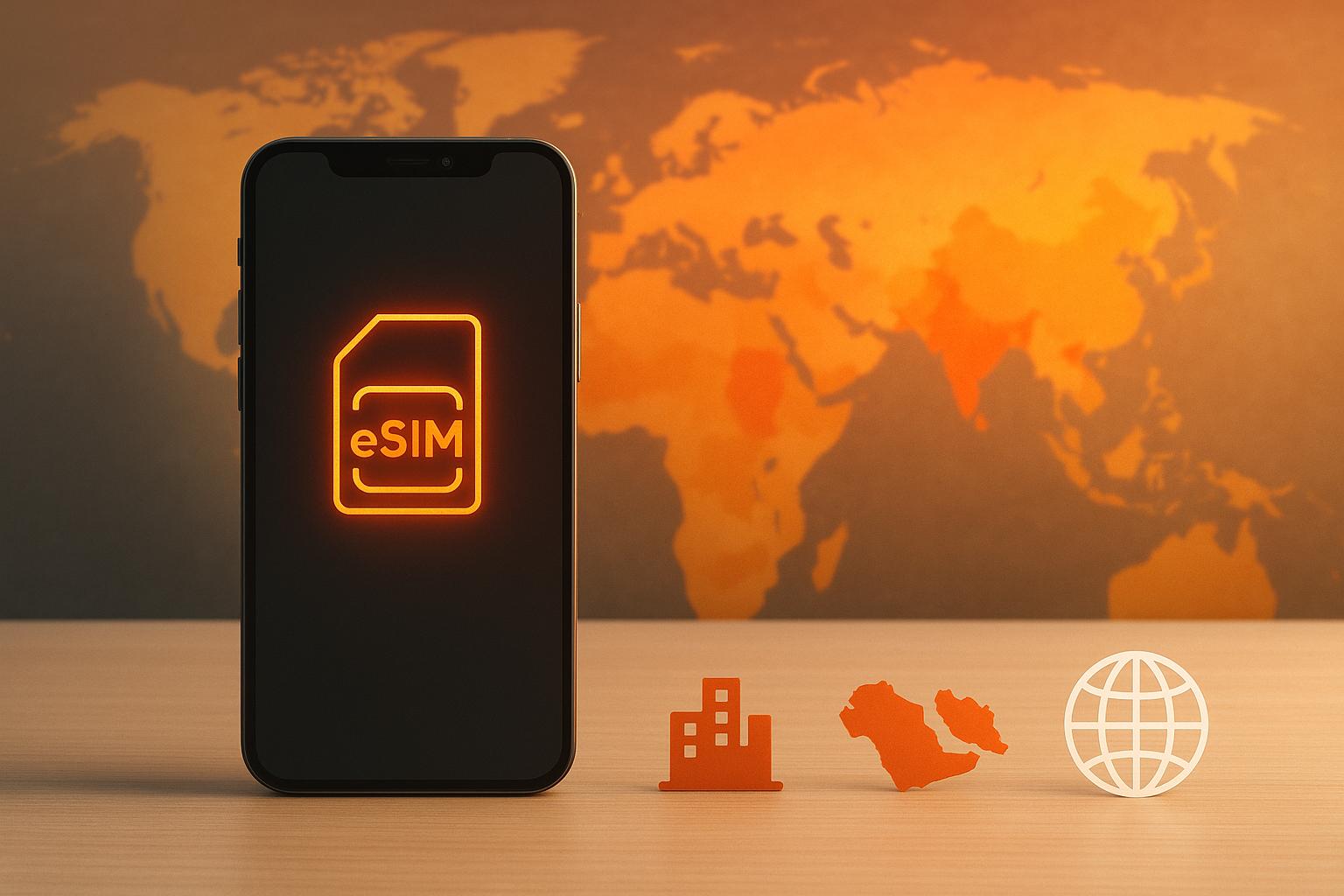eSIM Data Plans: Local vs Regional vs Global
https://www.zimconnections.com/esim-data-plans-local-vs-regional-vs-global/
 SHARE
SHARE
eSIMs have made staying connected while travelling easier and cheaper. They eliminate the need for physical SIM cards and reduce roaming fees significantly. By 2025, most smartphones support eSIMs, with travel plans offering data at competitive rates. But with three main options – local, regional, and global – choosing the right plan depends on your travel habits.
- Local Plans: Best for single-country trips, starting at £4.50 for 1GB. Ideal for short stays or single destinations but limited to one country.
- Regional Plans: Cover multiple countries in a region, like Europe or Southeast Asia. Prices start at £4.00 for 1GB. Great for multi-country trips but may include countries you don’t visit.
- Global Plans: Cover over 100 countries, starting at £3.00 for 1GB. Perfect for frequent travellers or digital nomads, though they cost more and may have fair usage limits.
Each type has its pros and cons, so the best choice depends on your travel patterns, data needs, and budget.
BEST 2025 International eSIMs Compared (5 Continents, 21 Months)
1. Local eSIM Data Plans
Local eSIM plans are designed to give you seamless connectivity within a single country, connecting you to local networks without extending coverage beyond the borders. Whether you’re exploring France, Japan, or the United States, these plans ensure you’re connected in your chosen destination.
Coverage Area
Unlike regional or global plans, local eSIMs are strictly limited to one country. This means you can’t share your data allowance across multiple destinations. If you’re planning to visit more than one country, you’ll need separate local eSIMs for each or opt for a more flexible plan type.
Cost (GBP)
Local eSIM plans are often the most budget-friendly option for single-country travel. Prices in the UK start at around £4.50 for 1 GB of data, with larger packages available, such as 40 GB for approximately £25. For those who prefer unlimited usage, daily plans are available for roughly £2.10 per day.
To give you an idea, a 10 GB plan in the UK is priced between £11.50 and £15.30, depending on the provider. Some providers even throw in extras like VPN services, ad blockers, and web protection at no additional charge.
Data Options
Local eSIM plans cater to a wide range of data needs, from 1 GB for light users to 40 GB for heavy users. Unlimited data plans are also available, although these often come with fair usage policies, such as a daily limit of up to 10 GB of full-speed data before potential speed reductions.
Providers like ZIM Connections offer local eSIM plans with unlimited data options, ensuring dependable 5G/4G connectivity. These plans frequently include a local phone number, which can be incredibly handy for SMS verification and local communication. This makes local eSIMs a versatile option for specific travel needs.
Best Use Cases
Local eSIM plans are perfect for short trips to a single destination where you need reliable connectivity right from the moment you arrive. They’re ideal for business travellers attending events, tourists exploring one location, or anyone who values instant access to mobile networks.
For longer stays, a traditional local SIM card might offer better value. However, the convenience of purchasing and activating a local eSIM before you even leave home is hard to beat. It saves you the hassle of finding a mobile shop, dealing with language barriers, or figuring out unfamiliar payment systems, ensuring you’re online the second you touch down.
2. Regional eSIM Data Plans
Regional eSIM plans are designed to keep travellers connected across multiple neighbouring countries without interruptions. Whether you’re exploring Europe, venturing through Southeast Asia, or travelling across other popular regions, these plans offer a convenient way to stay online. Let’s dive into the details of these plans, including their coverage, pricing, and data options.
Coverage Area
Regional eSIM plans provide coverage across several countries within a specific area, making it easy to stay connected as you move from one country to another. The number of countries covered varies depending on the provider. Some plans focus on just three countries, while others span entire continents. For instance, you’ll find plans tailored for Europe, Asia-Pacific, or Southeast Asia–Oceania. There are also more focused options for smaller regions, ensuring travellers have plenty of choices for their destinations.
Cost (GBP)
When it comes to pricing, regional eSIM plans sit comfortably between local and global options. They are particularly cost-effective for trips involving three or more countries. For example:
- A Europe plan covering 35 countries with 1GB of data costs about £4.00 for 7 days.
- A more focused plan for Italy, France, and Germany (3 countries) offers 1GB of data for around £2.90 for the same duration.
- For heavier data users, a 10GB Europe plan covering 36 countries starts at approximately £12.80.
The cost per GB decreases as you opt for larger data packages, making regional eSIMs a budget-friendly alternative to traditional carrier roaming. In fact, they can slash costs by 50–80% compared to standard roaming fees.
Data Options
These plans cater to a range of data needs, from light browsing to heavy streaming. Many providers offer flexible packages, and some, like ZIM Connections, even include unlimited data options. One major advantage is that the data allowance is shared across all covered countries. This means you won’t need separate data packages for each destination, simplifying your travel experience.
Best Use Cases
Regional eSIM plans are perfect for multi-country trips, removing the hassle of switching eSIM profiles as you cross borders. They also offer significant savings compared to buying individual local plans. Whether you’re enjoying a European city tour, exploring Southeast Asia, or on a business trip spanning several nations, a single activation ensures uninterrupted connectivity. However, if your travel plans are limited to just one or two countries, local eSIMs might be more budget-friendly. But as soon as your itinerary includes three or more destinations, regional plans quickly become the smarter choice.
sbb-itb-273ea09
3. Global eSIM Data Plans
Building on the advantages of regional packages, global eSIM plans take connectivity to the next level by covering multiple continents. These plans simplify staying connected across numerous countries with just one subscription.
Coverage Area
Global eSIM plans generally include coverage in over 100 countries. For instance, ZIM Connections offers access in more than 125 countries, ensuring connectivity whether you’re in bustling cities or more remote locations. This extensive reach comes with a price that reflects the premium nature of the service. Since coverage quality can differ between providers, it’s worth checking their coverage maps to confirm that your destinations are included.
Cost (GBP)
Designed for travellers hopping between continents, global eSIM plans come with a price that matches their extensive reach. Costs depend on the amount of data and the duration of validity. In the UK, you can expect prices to range from approximately £3–£4 for 1GB of data valid for 7 days to around £79 for a 10GB package lasting 30 days. For those visiting multiple regions, these plans can save both time and money compared to juggling separate local or regional options.
Data Options
These plans offer a variety of data packages, from as little as 1GB to as much as 100GB, with validity periods ranging from a week to an entire year. Some providers, like ZIM Connections, even offer unlimited data plans. Most packages include high-speed 5G or 4G connectivity, with the option to share data via hotspots. However, unlimited plans often come with fair usage limits after a certain threshold.
Best Use Cases
Global eSIM plans are ideal for travellers with intercontinental schedules and varying data needs. They are particularly beneficial for international business travellers, remote workers, digital nomads, and expats who require reliable connectivity without the hassle of switching to different local plans. With a single eSIM, users can enjoy uninterrupted service no matter where their travels take them.
Pros and Cons
Let’s break down the benefits and drawbacks of each eSIM plan type to help you decide which one suits your travel needs best. Each option has its own perks and limitations, making the decision largely dependent on where and how often you travel.
Local eSIM plans are a budget-friendly option if you’re travelling to a single country. They offer fast speeds and reliable connections since they operate directly on local networks. However, if you’re visiting multiple countries, you’ll need to purchase separate plans for each destination, which can become a hassle to manage.
Regional eSIM plans strike a balance between affordability and convenience. These plans cover multiple countries within a specific area, such as Europe, saving you the trouble of switching plans at every border. But there’s a catch – you might pay for coverage in countries you never visit, and the performance can vary depending on local network agreements.
Global eSIM plans are perfect for frequent flyers and digital nomads. They work in over 200 destinations worldwide, often with options for unlimited data and hotspot sharing, making them ideal for business travellers. The downside? They come with a higher price tag. Basic packages start around £3–£4, while more comprehensive 30-day plans can cost upwards of £79.
"It can be confusing! You need to have an idea of how much data you will use while on a trip and that can vary significantly from how much you use at home. I find it’s best to overestimate a little; most plans will allow you to add additional data if it turns out you miscalculated."
– Avi Greengart, president and lead analyst at Techsponential
When it comes to data allowances, local plans often provide the most data for the cost, while global plans may have fair usage policies that reduce speeds after reaching a limit. Regional plans typically offer moderate data packages, which are sufficient for most travellers.
Setting up these plans also varies. Local plans require careful planning and more effort if you’re visiting multiple countries. Regional plans are easier to manage, while global plans are the simplest – install once, and you’re ready to go across all covered destinations.
Here’s a quick reference table to compare the key points of each plan type:
| Plan Type | Coverage | Cost Range (GBP) | Best For | Main Limitation |
|---|---|---|---|---|
| Local | Single country | £0.80–£28.80 | Budget travellers, single destinations | Requires separate plans for multi-country trips |
| Regional | Multiple countries in one region | £4.00–£148.00 | Regional travel, European tours | Limited to specific geographic areas |
| Global | 200+ destinations worldwide | £3.00–£79.00+ | Business travel, digital nomads | Higher cost, potential fair usage limits |
Local plans generally deliver the fastest network speeds due to their direct ties with local carriers. Regional plans may see some variation in performance depending on the country, while global plans prioritise coverage over speed.
Customer support is another factor to consider. Local plans often provide assistance in the native language and time zone, while global plans typically offer 24/7 support – though it may lack the same level of local expertise.
Your travel habits play a big role in choosing the right plan. If you travel occasionally, local plans are the most cost-effective. Frequent travellers exploring specific regions can benefit from regional plans, while global plans are best for those who are always on the move and value convenience over cost.
Conclusion
When selecting an eSIM plan, think about your travel patterns and connectivity needs. The goal is to strike the right balance between cost, convenience, and coverage.
For trips to a single destination, local eSIM plans are a great choice. They’re affordable, offer fast connections, and provide reliable service. However, if your travel involves multiple countries, these plans might require extra effort to manage.
Regional eSIM plans simplify things for travellers exploring neighbouring countries. They remove the hassle of switching profiles at borders while offering coverage that’s both convenient and cost-efficient.
If you’re a frequent traveller or a digital nomad, global eSIM plans might be your best bet. While they come with higher upfront costs, they can save you as much as 80% compared to traditional roaming rates, making them a smart option in the long run.
To make the most of your eSIM plan, start by tracking your data usage for a week to determine how much you’ll need. Additionally, downloading maps and playlists in advance, enabling data-saving settings, and using secure Wi-Fi can help you cut costs even further.
FAQs
How can I choose the right eSIM plan for my travels?
Choosing the right eSIM plan starts with understanding your travel plans and how you’ll use your device. First, look at the coverage area. If you’re visiting just one country, a local plan might be all you need. But for trips spanning multiple countries, regional or global plans are often the better choice.
Next, think about your data needs. Some plans offer unlimited data, which is great if you’re a heavy user, while others provide tiered options that might suit lighter usage or shorter trips.
For frequent travellers, it’s worth checking if the plan connects to reliable networks and supports 5G connectivity where you’re headed. Flexibility is another important factor – some providers let you easily top up or adjust your plan as needed. And don’t overlook customer support. A provider with responsive and helpful service can make all the difference if you run into issues while abroad.
By matching these factors to your itinerary, you can choose an eSIM plan that fits your travel style and keeps you connected.
Are there any challenges with using global eSIM plans in remote areas?
Global eSIM plans aren’t without their challenges, especially in remote areas where network coverage might be patchy or local infrastructure unreliable. This can lead to slower internet speeds or even occasional disruptions in connectivity.
Another consideration is device compatibility. Not all devices are equipped to support every feature of a global eSIM, which could limit its functionality in some regions. To avoid surprises, it’s wise to review the coverage map and confirm your device’s compatibility before depending on a global eSIM in less accessible locations.
How can I reduce my data usage when using an eSIM plan abroad?
To get the most out of your eSIM data plan while travelling abroad, start by switching on Data Saver mode on your device. This feature reduces background activity, helping to minimise unnecessary data usage.
Another smart move is to download maps, music, or any other content you might need before your trip. Having these available offline can significantly lower your data consumption while you’re away. Also, make a habit of connecting to Wi-Fi networks whenever you can – whether you’re at a hotel, a café, or in a public area.
Lastly, tweak your device settings to limit background activity for non-essential apps. By ensuring only the apps you need are using data, you can stay connected without worrying about exceeding your plan’s limits.









































































































































































































